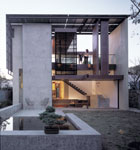
It started with a kitchen fire. Westbrooke is a three-story brick building with 24 units located in Dayton. The property owner’s office is in Columbus, and we do all of their insurance restorations claims, so when they called, we ran out there so we could put an estimate together.
It’s always striking when you first pull up. You see a street or court full of buildings, and the line of the roofs catches your eye—but then, suddenly, there’s one building with no roof at all. You realize when you look up through windows—you see the sky instead of ceiling. There’s smoke stain on the exterior brick, and debris is scattered all around the building. [Westbrooke] was a large loss. The roof was off three quarters of the building, and what was left was too damaged to keep. All of the units were gutted.
The first thing we did was secure the property. Building property was exposed, and individuals had been forced to leave their personal property. The owner wanted to minimize loss from theft and vandalism, so we erected a chain-link fence and padlocked it. Once we determined that the remaining roof and hanging debris couldn’t fall, we let residents in to look for personal effects.
Meanwhile, we started drawing up prints and applying for demolition and construction permits. How long that takes differs between municipalities. In Dayton it took almost three months because the city is very involved. The health department was worried that there was asbestos and we might disturb it. When we pointed out that the building isn’t old enough to have asbestos, the health department said the floors were vinyl, which might have asbestos, and they didn’t want us touching them. When we explained that we couldn’t touch the floors because they were covered by two feet of debris, the health department said they wanted us to bring in equipment so we could contain the possible asbestos when we worked. We said, “It’s already uncontained because there’s no roof and no windows.” That’s not unusual. There’s been an influx of regulations in the industry over past two years—literally thousands—making it more and more difficult to do anything. And we have to be careful because fines have doubled and tripled. Permits and inspections—in this case—made up roughly 50 percent of the process.
We start by clearing out the debris. We cleared the yard, then went through the building floor by floor and room by room. For a large job like this, we have a big JLG telescoping boom. We extended right up to windows, threw debris into an eight-foot bucket, retracted, and placed the debris in large dumpsters. Then we broom-swept the building to prepare it for other parts of the demolition, such as firestopping, wiring, and plumbing. We had to get a clean frame so we could start putting everything back.
Finally, we started putting it all back together again. There were two stages: rough-in and finish. We started with the rough-in, putting back the electrical, HVAC, and plumbing, all of which were inspected processes. Then the structure also got an inspection at the rough-in point, as did the insulation. Then we started all over with the finish process—drywall, vents, faceplates—and more inspections for electrical, HVAC, plumbing, and structure. In the end, the building was like new. A $50,000 job might be completed in a few weeks, depending on the municipality. Westbrooke took seven months. ABQ


